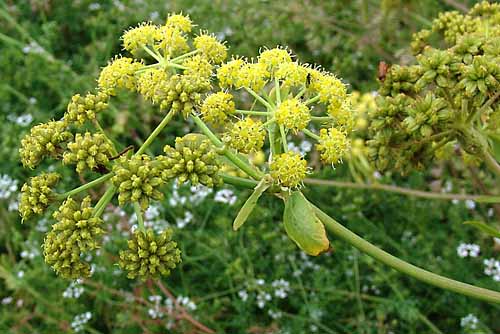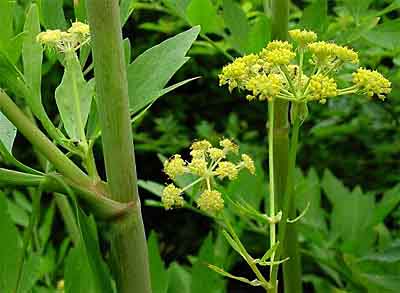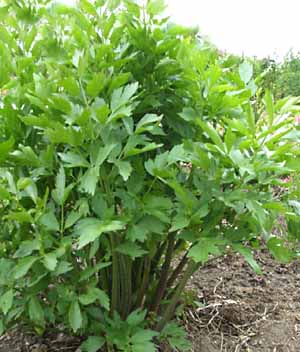Description of Lovage (Levisticum officinale).
A large perennial plant that somewhat resembles celery. The leaves are large dark green composite leaves made up of many leaflets that are usually roughly three lobed with serrated margins and arranged in pairs opposite on the stem with the leaflets becoming smaller towards the point. The whole leaf can be 28 inches (70cm) long and are shiny. The leaves grow in a rosette from a thick fleshy root often shaped like a carrot that can reach 6 inches (15 cm) in length. This is grey or brownish color on the outside and white within. It has a strong aromatic smell and taste. The plant and its roots increase in size every year. The leaves first from a large clump up to a foot in height in mid to late spring and can be up to 3 feet (91 cm) across. In early summer the plant sends up large robust hollow angled stems that branch as they grow up to 4 - 6 feet (121-183 cm) in height. Each branch is topped by a compound umbel each made up of a small round cluster of greenish yellow flowers each cluster being 1 ½ to 4 (4-10 cm)inches across. All parts of the plant have a strong odor similar to celery.
Growing Lovage (Levisticum officinale) from seed.
Lovage can be slow to germinate and fresh seed give much better results. They can be sown directly into the ground but more weeding may be needed until they have germinated. Seeding in pot is recommended for an early start. Seeds are fairly large so use individual pots when seeding sow about ¼ inch (0.6 cm) deep. Grow on until plants are fairly large before planting out. Plant about 2-3 feet (61-91cm) apart as plants can grow quite large. Some sources suggest sowing in later summer of fall but here in zone 6 we find plants do not do well over the winter unless started in the spring. Warmer zone may have more success with fall plantings. For more details on growing seeds see our General Growing Instructions.
Location and Care of Lovage (Levisticum officinale).
Hardy to zone 3. Lovage prefers a sunny location but it can take some shade. The best soil is one with a high level of organic material but is also well drained. However Lovage will grow fairly well on most soils provided they are well draining, it cannot tolerate heavy clay or waterlogged soils. Adding organic material to the soil before planting is advised along with and side dressing of mulch or compost during the year this will ensure a strong healthy plant. It also prefers a pH range between 5.0 and 7.6. Lovage does need water, a soaker hose or trickle irrigation in areas where rainfall is sporadic will benefit the plants. If plants become too large they can be divided in the fall. In good conditions lovage plants will get bigger with each passing year so ensure it is given enough room without crowding out other plants. Since it grows so tall it is best planted on the northern side of any garden especially a herb garden so that it does not shade out any of the other plants. Under good conditions lovage will self seed so ensure that seed heads are removed before the seed drops to prevent being overtaken by the large plants. If plants become too large they can be divided in the fall. Plant at least two feet apart as they will increase in size. Plants can begin to loose their vigor after six or more years so digging them up and dividing and replanting the larger roots will help them remain strong and energetic. Lovage plants are slow to develop and can take a year or more to reach a reasonable size. They will not flower until their second year and if struggling in their location may take as long as four years to flower.
If living in a colder zone (6 or higher) add a layer of mulch over the plants in the winter to keep the roots warmer and protect them from the winter. They survive much better this way if soil is too cold the roots may freeze and die. However lovage does do better in colder areas where there is a period of dormancy than in warmer zones.
Pests.
Leaves may be attacked by leaf miners. Aphids are attracted to the flowers and yellowish, gummy, resinous juice. This may then attract ants which feed on the aphid residue. The large fleshy roots may be attacked underground if there are moles and voles in the area. Moles often dig tunnels near plants which give voles access, and they will then eat the roots out from beneath the plant.
Harvesting Lovage (Levisticum officinale).
Plants should not be harvested in the first year, they need time to develop their root system and establish themselves. Harvest from second year onwardsLeaves. Harvest only some leaves and take from strong large clumps, don't take leaves from weaker plant allow them to establish first. Leaves can be harvested at any time of day but the best time in morning after the dew has evaporated. Leaves are best before the plant begins to flower but can be used at any time. Leaves can be dried in bunches, on screens in the sunshine or a dehydrator.
For freezing blanch the leaves briefly in hot water and freeze in bags.
Seed. Ripe seed is a straw to dark brownish color. Time harvesting so that seed is just brown before seed is too ripe and drops to the ground. Not all the seed will ripen at the same time so individual heads can be snipped off with scissors and dropped into a bin or bucket. Or you can take whole branches and dry the seed yourself. Make sure seed is almost ripe as green seed will not ripen when dry. Store seed in airtight containers, make sure it is very dry first.
Roots. Only harvest roots from large plants. Small plants will not have developed a large enough root system to be worth the effort of digging. This may be at the end of the second year but it may take longer assess your plants before digging. Wash roots thoroughly and dry either by hanging, on screens or in a dehydrator.
Culinary uses of Lovage (Levisticum officinale).
The leaves are the most commonly used as flavoring but roots and seeds have the same taste and can also be used. The leaves can be used in soups stews salads and impart a unusual flavor. Lovage is a great flavoring for desserts try using it for ice cream, sorbet or water ice! There is nothing that tastes anything like it. A tea can also be made from the leaves or the grated roots. The root can be cooked as a vegetable . It is also used to flavor preserves and in confectionary in France, the stalks can be cooked like celery.
Medicinal Uses of Lovage (Levisticum officinale).
Lovage tea is used to help all kinds of digestive problems in stimulate the digestion and to help with flatulence (gas) and for colic in children. It is also used to treat headaches and kidney problems. Externally it is used to treat pinkeye and as a gargle.
Other Names.
Garden lovage, Bladder seed, Love Parsley, Cornish Lovage, Italian Lovage, Love Persley, Old English Lovage, Sea Parsley.








